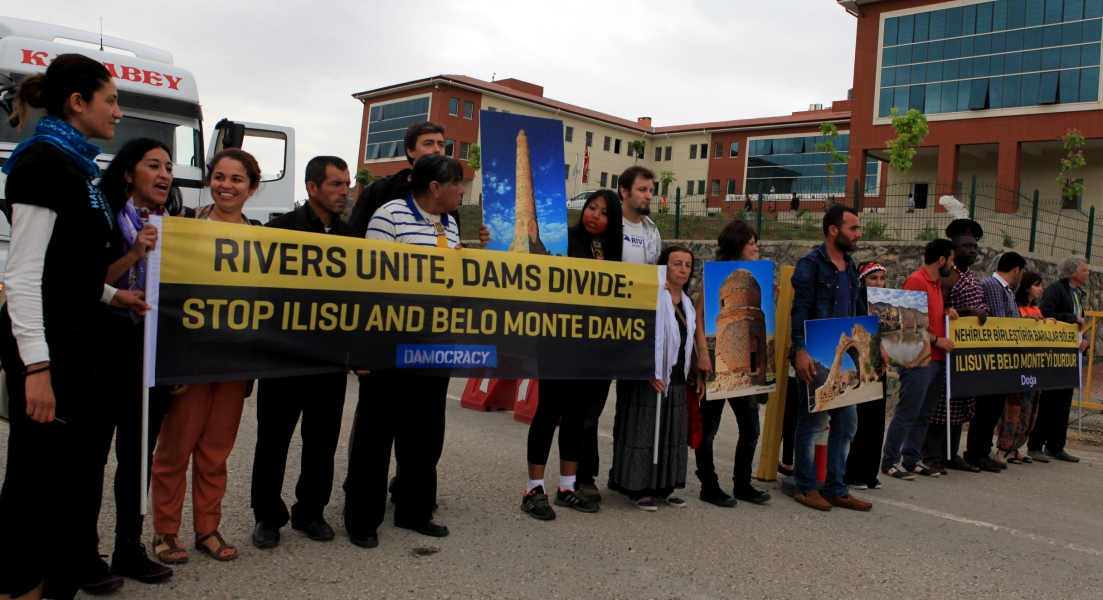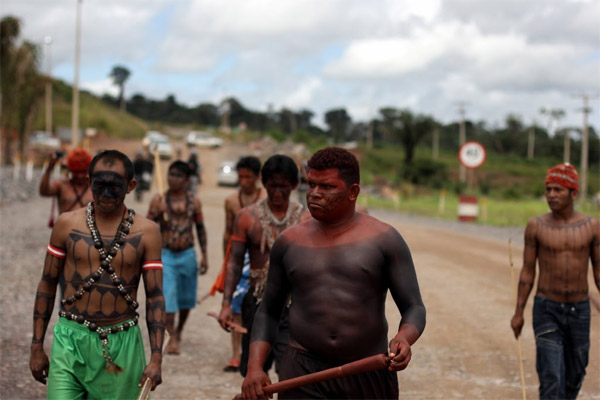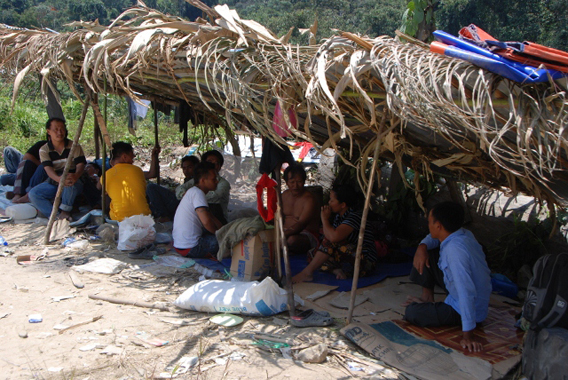
by Deep Green Resistance News Service | May 28, 2013 | Obstruction & Occupation
By Amazon Watch
Today [May 21, 2013] representatives of dam-affected communities and organizations from South America, the Middle East, Europe, the US and Africa, including Brazilian indigenous leaders accompanied by Amazon Watch, blocked the entrance to the construction site of the Ilisu dam in southeast Turkey demanding an end to controversial development that would sink an ancient city dating back to the Bronze Age.
Some 20 people including Kayapó Chief Megaron Txucarramae, one of Brazil’s most noted indigenous leaders in the struggle against the Belo Monte dam in the Amazon, held up banners in English and Turkish reading ‘Rivers Unite, Dams Divide: Stop Ilisu and Belo Monte dams.’ Delegates from the International Rivers Conference held in Istanbul last Saturday joined local protestors to show solidarity with their struggle to stop the Ilisu dam on the Tigris River, Turkey’s last free-flowing river.
“The peace process cannot be completed without the cancellation of the controversial Ilisu dam project and the protection of Hasankeyf. At the same time, damming the Tigris and Euphrates rivers and stopping their flow reaching Syria and Iraq is a contradiction to Turkey’s ‘zero problems’ policy with its neighbors because the increasing water crisis in the Mesopotamian basin may lead to increased conflict,” said Dicle Tuba Kilic, Rivers Program Coordinator for Doga (BirdLife Turkey).
The Belo Monte dam in Brazil and the Ilisu dam in Turkey are two of the most controversial mega-dam projects in the world today. Both dams are located in cultural and natural hotspots, inflicting devastating consequences and displacing over 75,000 people in Amazonia and Mesopotamia. In addition, the Ilisu dam, located a few kilometers from the Iraqi border, will affect the livelihood of Marsh Arabs living in the newly restored Basra Marshes. Turkey controls the Tigris and Euphrates headwaters, which dictates how much water flows downstream into Syria and Iraq.
“Our struggle to preserve the Xingu River from the Belo Monte dam is no different from the fight to protect the Tigris River from the Ilisu dam. We are unified in our positions to say ‘no’ to our governments. You cannot kill a river that sustains its people and culture,” said Kayapó Chief Megaron Txucarramae.
Legal and political controversies have surrounded the push to build the Belo Monte and Ilisu dams. No adequate Environmental Impact Assessment has been carried out for either dam, and both governments have failed to implement prior consultations and mitigation plans to protect the environment and rights of affected communities. Both dams proceed despite court rulings halting their construction and widespread national and international opposition to their development.
Faced by governments steamrolling human rights and environmental protections, dam-affected communities are uniting their struggle under the DAMOCRACY banner. DAMOCRACY includes 15 national and international organizations from all corners of the globe. Among them are Doga Dernegi, Amazon Watch, International Rivers, and RiverWatch.
Damocracy is produced by Doga Dernegi (BirdLife Turkey), in collaboration with other founding members of the Damocracy movement: Amazon Watch, International Rivers, RiverWatch, Gota D’água (Drop of Water) Movement, Instituto Socioambiental (ISA) and Movimento Xingu Vivo para Sempre (MXVPS).
To watch the documentary, visit: http;//www.youtube.com/DamocracyTV
From Amazon Watch: http://amazonwatch.org/news/2013/0521-international-activists-block-ilisu-dam-construction-site-in-turkey

by Deep Green Resistance News Service | May 5, 2013 | Biodiversity & Habitat Destruction, Colonialism & Conquest, Indigenous Autonomy, Obstruction & Occupation
By Mongabay
On Thursday roughly 200 indigenous people launched an occupation of a key construction site for the controversial Belo Monte dam in the Brazilian Amazon. The protestors, who represent communities that will be affected by the massive dam, are demanding immediate suspension of all work on hydroelectric projects on the Xingu, Tapajós and Teles Pires rivers until they are properly consulted, according to a coalition of environmental groups opposing the projects.
The protestors include members of the Juruna, Kayapó, Xipaya, Kuruaya, Asurini, Parakanã, Arara, and Munduruku tribes. Non-indigenous fishermen and riverine community members that will also be affected by Belo Monte have also reportedly joined the demonstration. Organizers say the occupation will continue “indefinitely or until the federal government meets their demands.”
“Today’s protest demonstrates the relentless resistance of a growing group of united peoples against Belo Monte, Tapajós and destructive dams throughout the Amazon,” said Leila Salazar-Lopez, Amazon Watch Program Director, in a statement. “These are the final moments to change course as construction closes in on the Xingu and other lifeline rivers of the Amazon.”
Belo Monte has been the site of several protests since the Brazilian government finalized approval of Belo Monte. Indigenous groups, local fishermen, and environmentalists are strongly opposed to the project, while will divert nearly 80 percent of the flow of the Xingu river, one of the Amazon’s mightiest tributaries. The dam will flood tens of thousands of hectares of land, displace more than 15,000 people, and could push several endemic fish species to extinction. Belo Monte, which will operate at less than 40 percent of capacity despite its $15 billion dollar price tag, will require additional upstream dams to be commercially viable, according to independent analysts, potentially amplifying the project’s impact.
Belo Monte and other dams on the Xingu represent just a small fraction of the hydropower projects being developed by Brazil in the Amazon Basin. According to an analysis published last year, 231 dams are currently planned in the Brazilian Amazon alone. Another 15 are slated for Peru and Bolivia.
Ecologists say there are myriad problems with large dams in tropical ecosystems, especially when built on the scale envisioned in the Amazon. Large dams interfere with the hydrological cycle and nutrient flows through an ecosystem, while restricting or blocking access to breeding and feeding grounds for migratory fish species. Meanwhile areas inundated with water can generate substantial greenhouse gas emissions. Design flaws in some tropical dams, which draw methane from the base of their reservoirs, can exacerbate climate impacts. Finally flooding in the reservoir area can displace communities traditionally dependent on rivers, while creating hardship downstream from degraded fisheries.
From Mongabay: “Tribesmen launch ‘occupy’ protest at dam site in the Amazon rainforest“
by Deep Green Resistance News Service | Apr 9, 2013 | Biodiversity & Habitat Destruction, Colonialism & Conquest, Indigenous Autonomy
By Jonathan Watts / The Guardian
An Amazonian community has threatened to “go to war” with the Brazilian government after what they say is a military incursion into their land by dam builders.
The Munduruku indigenous group in Para state say they have been betrayed by the authorities, who are pushing ahead with plans to build a cascade of hydropower plants on the Tapajós river without their permission.
Public prosecutors, human rights groups, environmental organisations and Christian missionaries have condemned what they call the government’s strong-arm tactics.
According to witnesses in the area, helicopters, soldiers and armed police have been involved in Operation Tapajós, which aims to conduct an environmental impact assessment needed for the proposed construction of the 6,133MW São Luiz do Tapajós dam.
The facility, to be built by the Norte Energia consortium, is the biggest of two planned dams on the Tapajós, the fifth-largest river in the Amazon basin. The government’s 10-year plan includes the construction of four larger hydroelectric plants on its tributary, the Jamanxim.
Under Brazilian law, major infrastructure projects require prior consultation with indigenous communities. Federal prosecutors say this has not happened and urge the courts to block the scheme which, they fear, could lead to bloodshed.
“The Munduruku have already stated on several occasions that they do not support studies for hydroelectric plants on their land unless there is full prior consultation,” the prosecutors noted in a statement.
However, a court ruling last week gave the go-ahead for the survey. Government officials say that neither researchers nor logistical and support teams will enter indigenous villages. The closest they will get is about 30 miles from the nearest village, Sawré Maybu.
The ministry of mines and energy noted on its website that 80 researchers, including biologists and foresters, would undertake a study of flora and fauna. The army escort was made possible by President Dilma Rousseff, who decreed this year that military personnel could be used for survey operations. Officials say the security is for the safety of the scientists and the local population.
Missionaries said the presence of armed troops near Sawré Maybu village, Itaituba, was intimidating, degrading and an unacceptable violation of the rights of the residents.
“In this operation, the federal government has been threatening the lives of the people,” the Indigenous Missionary Council said. “It is unacceptable and illegitimate for the government to impose dialogue at the tip of a bayonet.”
The group added that Munduruku leaders ended a phone call with representatives of the president with a declaration of war. They have also issued open letters calling for an end to the military operation. “We are not bandits. We feel betrayed, humiliated and disrespected by all this,” a letter states.
One of the community’s leaders, Valdenir Munduruku, has warned that locals will take action if the government does not withdraw its taskforce by 10 April, when the two sides are set to talk. He has called for support from other indigenous groups, such as the Xingu, facing similar threats from hydroelectric dams.
Environmental groups have expressed concern. The 1,200-mile waterway is home to more than 300 fish species and provides sustenance to some of the most biodiverse forest habitats on Earth. Ten indigenous groups inhabit the basin, along with several tribes in voluntary isolation.
With similar conflicts over other proposed dams in the Amazon, such as those at Belo Monte, Teles Pires, Santo Antônio and Jirau, some compare the use of force to the last great expansion of hydropower during the military dictatorship.
“The Brazilian government is making political decisions about the dams before the environmental impact assessment is done,” said Brent Millikan of the International Rivers environmental group.
“The recent military operations illustrate that the federal government is willing to disregard existing legal instruments intended to foster dialogue between government and civil society.”
From The Guardian: http://www.guardian.co.uk/environment/2013/apr/03/brazil-dam-activists-war-military
by Deep Green Resistance News Service | Mar 29, 2013 | Biodiversity & Habitat Destruction
By Emily Ford / The Times
About 28,000 rivers have disappeared from China’s state maps, an absence seized upon by environmentalists as evidence of the irreversible natural cost of developmental excesses.
More than half of the rivers previously thought to exist in China now appear to be missing, according to the 800,000 surveyors who compiled the first national water census, leaving Beijing fumbling to explain the cause.
Only 22,909 rivers, covering an area of 100 square kilometres were located by surveyors, compared with the more than 50,000 present in the 1990s, a three-year study by the Ministry of Water Resources and the National Bureau of Statistics found.
Officials blame the apparent loss on climate change, arguing that it has caused waterways to vanish, and on mistakes by earlier cartographers. But environmental experts say that the disappearance of the rivers is a real and a direct manifestation of headlong, ill-conceived development, where projects are often imposed or approved without public consultation.
The United Nations considers China one of the 13 countries most affected by water scarcity, as industrial toxins have poisoned historic water sources and were blamed last year for causing the Yangtze to turn an alarming shade of red. This month the carcasses of about 16,000 dead pigs dumped in the river have been pulled from its waters, and 1,000 dead ducks were found dumped this week in the Nanhe River in the southwestern Sichuan province.
Ma Jun, a water expert at the Institute of Public and Environmental Affairs, said that the missing rivers were a cause for “great attention” and underscored the urgent need for a more sustainable mode of development.
“There might be some disparity [in the number of rivers] due to different research methods. However, the disappearance of rivers is the reality. It is really happening in China because of the over-exploitation of river resources,” Mr Ma said. “One of the major reasons is the over-exploitation of the underground water reserves, while environmental destruction is another reason, because desertification of forests has caused a rain shortage in the mountain areas.”
Large hydroelectric projects such as the Three Gorges Dam, which diverted trillions of gallons of water to drier regions, were likely to have played a role, Mr Ma said.
The census charted a decline in water quality, citing the “severe over-exploitation” of underground water reserves by 60 of its biggest cities.
The report came as Li Keqiang, the new premier, gave a speech in which he pledged greater transparency on pollution, which Beijing fears is a potential catalyst for social unrest.
“We must take the steps in advance, rather than hurry to handle these issues when they have caused a disturbance in society,” Mr Li was quoted by state media as saying.
The missing rivers provoked wistful recollections among Chinese internet users, most of whom will have witnessed dizzying urbanisation.
“The rivers I used to play around have disappeared, the only ones left are polluted, we can’t eat the fish in them, they are all bitter,” a person using the name Pippi Shuanger wrote on Weibo, the Chinese version of Twitter.
Despite water shortages, the threat of floods is a problem for much of the Chinese mainland, with two thirds of the population living in flood-prone areas. Flash floods caused by heavy rain claimed the lives of 77 people in Beijing last July.
From The Times: http://www.thetimes.co.uk/tto/environment/article3725724.ece

by Deep Green Resistance News Service | Feb 9, 2013 | Indigenous Autonomy, Obstruction & Occupation
By Agence France-Presse
A Malaysian state minister Friday said the government would not push ahead with building a dozen new dams on Borneo island, acknowledging they have caused outrage from local tribes and environmentalists.
The proposals sparked fears that the dams would destroy pristine rainforests, endanger wildlife, and displace natives in Sarawak, a Malaysian state crossed by powerful rivers with rich jungle habitats.
“It is not a firm plan to build 12 dams. I don’t think we will need that. We will only need four,” James Masing, Sarawak’s state minister of land development, told AFP in an interview.
Masing said the government was backing off in response to widespread criticism. Protests over the years have seen activists and locals staging blockades of roads into dam areas.
“I’m pleased that this type of thing (protests) takes place. Not all that we do is correct, and this shows we need to refine our plans and think again,” he said.
The now-complete Bakun mega-dam, which is not part of the new dam proposal, has already been dogged for years by claims of corruption in construction contracts, the flooding of a huge swathe of rainforest and the displacement of thousands of tribespeople.
Despite that, the government mooted constructing more dams as part of an industrial development drive to boost the resource-rich state’s backward economy.
Another dam at Murum, also deep in the interior, is nearing completion and two others are in the planning stages as part of the new proposal.
Together the four dams — at Bakun, Murum, Baleh and Baram — are already expected to put out nearly 6,000 megawatts of power, six times what Sarawak currently uses, Masing said.
“The protests are becoming more vocal on the ground so (the dam rethink) is a very good development for me,” said Peter Kallang, member of a Sarawak tribe and chairman of SAVE Rivers, an NGO that has campaigned against the dams.
However, he said plans for the Baram and Baleh dams should be scrapped as well, noting that the Baram dam would displace about 20,000 people, compared to about 10,000 at Bakun, and destroy irreplaceable forest.
He said SAVE Rivers last month organised a floating protest along the Baram river that cruised down river for three days and was met with support along the way by local tribespeople.
Kallang and other activists have also travelled abroad to lobby against the dams, including meeting officials of Hydro Tasmania, an Australian corporation that advises the Sarawak government on the dams.
The Tasmania government corporation pledged in December after meeting the activists that it would pull its personnel out of Sarawak by the end of 2013, Kallang said.
Sarawak’s tribes — ethnically distinct from Malaysia’s majority Malays — fear that they will lose their ancestral lands and hunting and burial grounds, as the government encourages them to make way for projects and move into new settlements.
Those are equipped with medical clinics, electricity, and Internet access. But village elders and activists say alcoholism, drug use, and crime are on the increase and anger is rising over continuing encroachment on native lands.
In one of the blockades in 2011, Penan tribespeople blocked roads into their lands for a week to protest logging and alleged river pollution by Malaysian firm Interhill until the blockade was dismantled by authorities.
Read more from Global Post



